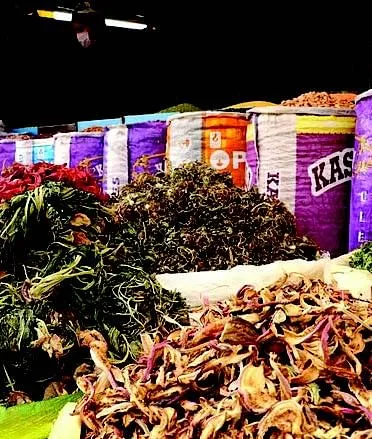For centuries, sun-dried vegetables, locally known as “Hokh Syun” have been a popular winter tradition among the people of Kashmir. These dried vegetables, which include a variety of items such as Brinjal (Wangan Hach), Tomatoes (Ruwangan Hach), Turnip (Gogji Are), and Bottle Gourd (Al Hach) are enjoyed as a staple food during the harsh winter months.
However, in recent years, some have expressed concerns about the safety of these dried vegetables and whether they contain carcinogenic elements. With increasing awareness of health and wellness, many people are questioning whether these dried foods are safe for consumption.
The good news is that prominent oncologists in the valley have debunked these fears, stating that there is no scientific evidence linking sun-dried vegetables to cancer.
Instead, the potential harm lies in pickling or preserving the vegetables with preservatives or chemicals. These additives can contain harmful elements that may increase the risk of cancer.
However, eating sun-dried vegetables in moderation is considered safe. According to doctors, consuming sun-dried vegetables once or twice a week does not pose any health concerns.
But continuously consuming these dried vegetables can have negative health consequences.
Additionally, if there is any fungus present on the dried vegetables, it is important to be cautious as it may contain harmful toxins.
Despite these concerns, many people still prefer to eat sun-dried vegetables, as they are considered a delicious and nutritious traditional food.
During the winter months, these dried vegetables are widely available in local markets, and many families still preserve them at home for the winter months.
Dried vegetables have been an important part of the food culture in Kashmir for centuries.
The process of drying or dehydrating food involves removing moisture to preserve it, and in Kashmir, this has been a long-standing tradition, especially in the winter months.
During this time, people would flock to local markets to purchase dried vegetables and fish as a staple food source.
The tradition of ‘Hokh Syun’ can be traced back to the harsh winter conditions in Kashmir, where fresh vegetables were not readily available. By drying and preserving the vegetables, people were able to store food for the winter and ensure a steady supply of food. Over time, the consumption of these vegetables have become a cultural norm, with families passing down recipes and techniques from generation to generation.
Today, despite the availability of fresh vegetables in the market, many Kashmiris continue to consume these sun-dried vegetables. The dried vegetables have become a staple in many households and a symbol of the region’s rich food culture.
Till date, there is limited scientific research on the health effects of consuming sun-dried vegetables. However, based on the available evidence, it appears that sun-drying does not pose a significant risk to human health, as long as the drying process is done properly. The dried vegetables should be free of preservatives, chemicals, and other harmful substances.
Experts believe that there is no harm in consuming sun-dried vegetables as long as preservatives are not added to it. They suggest that the pickling of vegetables and the use of chemicals for preservation can lead to harmful health effects, but there is no evidence that sun-drying alone is harmful.
However, there are some cautions to be considered. For example, if sun-dried vegetables become contaminated with fungal toxins, they may pose a health risk, particularly to people who consume them frequently. It is also important to be mindful of the cooking methods used, as grilling or roasting meat on charcoal can result in a buildup of carbon, which is harmful to health.
In conclusion, while more research is needed to fully understand the health implications of consuming sun-dried vegetables, based on the available evidence, consuming these dried vegetables once or twice a week does not pose a significant health concern. However, it is important to be mindful of the drying and preservation methods used to ensure the food is free of harmful substances.
DISCLAIMER: The views and opinions expressed in this article are the personal opinions of the author.
The facts, analysis, assumptions and perspective appearing in the article do not reflect the views of GK.






